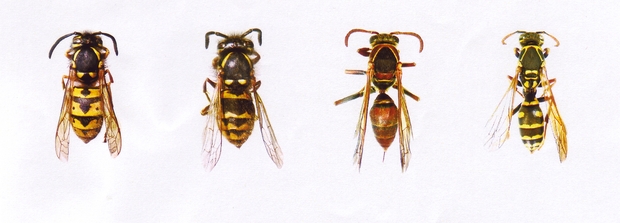
Some of the members of the Moths and Butterflies of New Zealand Trust: from left to right Jacqui Knight (secretary), Beverley Sinclair, Cheryl Krull and Sonia Dickson with dogs Bonnie and Clyde - and on the left, a Monarch butterfly chrysalis in Jacqui Knight’s Blockhouse Bay garden. (images: Lisa Thompson)
No butterflies and lots of wasps - that's the message Jacqui Knight, the secretary of the Moths and Butterflies of New Zealand Trust (formerly the Monarch Butterfly New Zealand Trust) receives from many people who try to encourage Monarch butterflies in the gardens.
A self-described butterfly lady, Jacqui plants her garden with a wide variety of plants, all aimed at enticing Monarchs to find a suitable leaf to lay their eggs on. But the 2013/14 summer has proven far from productive in her Blockhouse Bay garden - and she’s not alone. "Monarch lovers up and down the country have been asking what has happened to the big, bright orange butterflies this summer.”

The decline in numbers has been noted across the country and Jacqui says she’s fielded many messages about Monarch caterpillars being targeted and killed by increasing numbers of wasps (images above and below: Landcare Research). Darren Ward is an ecologist at Landcare Research and says that while warm and mild weather over the past couple of years is partly to blame for the explosion of wasp numbers, they are assisted by one of the latest pests to get across the border - the giant willow aphid.
The aphid was first found in December 2013 and has now been confirmed as far south as Canterbury. It feeds on willow trees and causes them to weep honeydew, which is then eaten by the wasps, causing their numbers to swell. Once fuelled up on sugar they look for protein to feed to their young, and Monarch caterpillars provide a food source.
An article in the latest New Zealand Science Review labels social wasps (Vespula germanica and Vespula vulgaris) as New Zealand's most abundant, widespread and damaging invertebrate pests, which can reach densities of over 350 insects per square metre.
Victoria University biologist Phil Lester is a co-author of the article and a member of the recently formed Wasp Tactical Group. He says to develop a pathway to a New Zealand free of the wasp burden, summer densities need to be radically reduced by 80 to 90 per cent of current levels. He says while wasp control through bait stations could be an effective solution, commercial restrictions around broad spectrum insecticides have so far prevented any bait products containing such toxins being manufactured for commercial purposes.
However, a tiny mite could provide the breakthrough scientists are looking for in quelling wasp numbers. During a recent study on the ecology of European wasps a researcher at Landcare Research serendipitously discovered mites on the wasps. Infected wasps had deformed wings and heavily infected wasp colonies collapsed. Researchers have been granted $430,000 over three years to investigate ways to use the mite to control wasp populations.
In the interim, Jacqui Knight suggests Monarch enthusiasts place curtain netting over swan plants. Monarchs will still lay eggs on leaves touching the netting but the caterpillars won’t be picked off by wasps.


